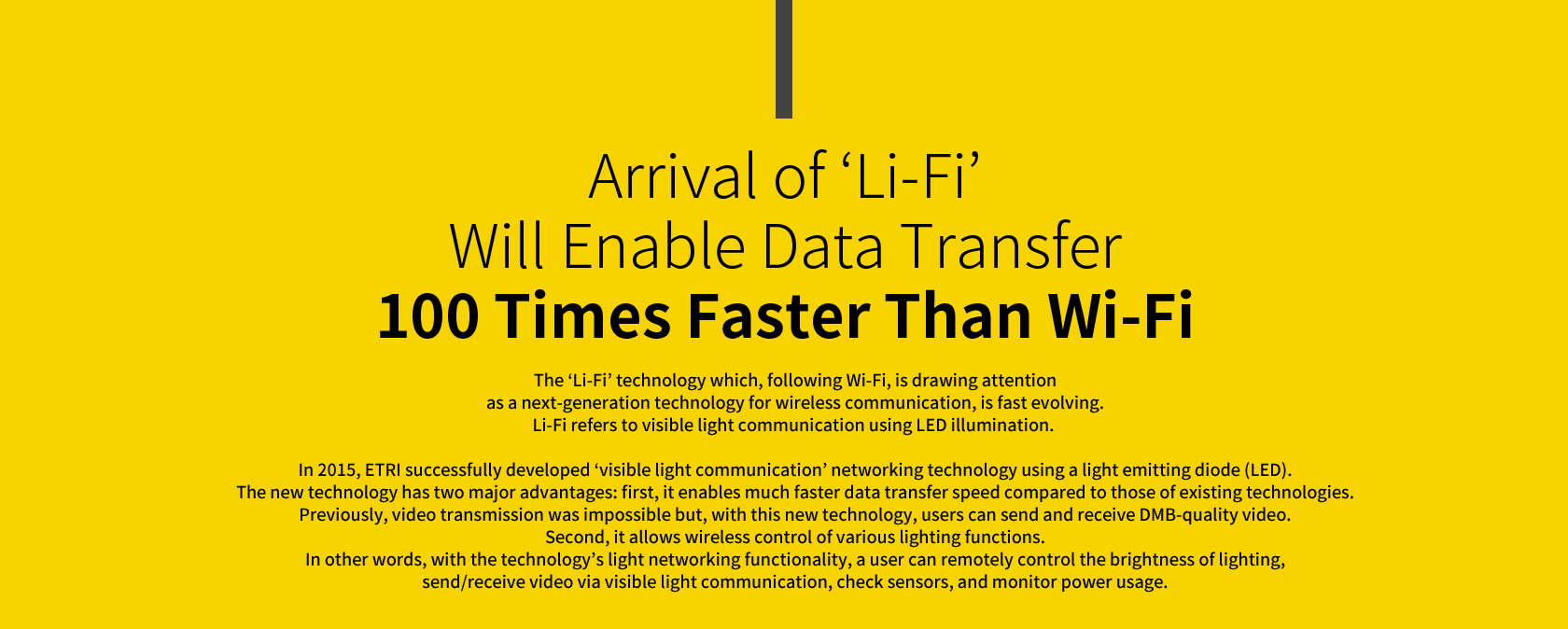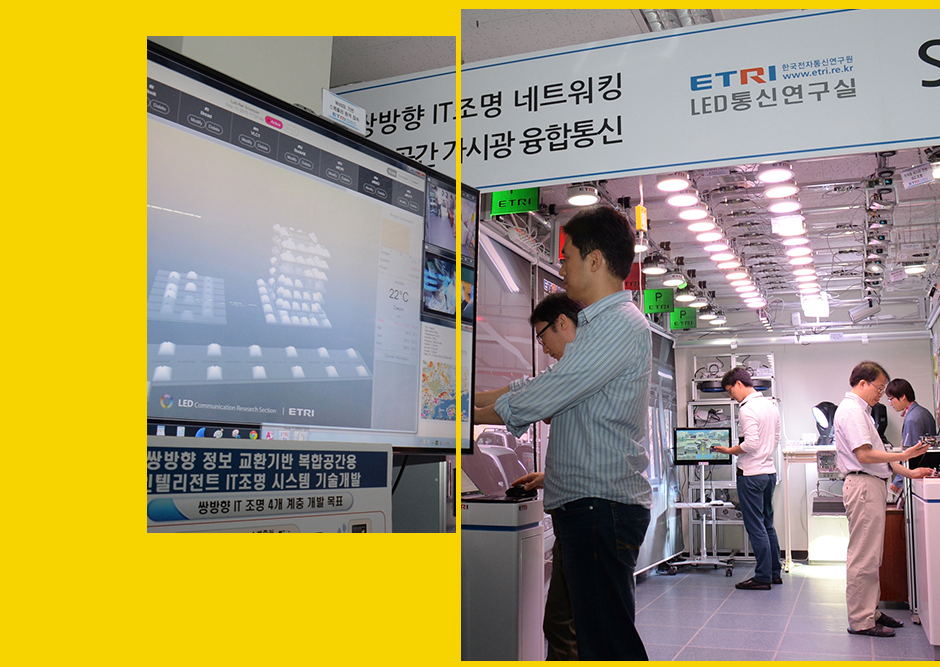





Arrival of ‘Li-Fi’
Will Enable Data Transfer
100 Times Faster Than Wi-Fi
The ‘Li-Fi’ technology which, following Wi-Fi, is drawing attention as a next-generation technology for wireless communication, is fast evolving. Li-Fi refers to visible light communication using LED illumination.
In 2015, ETRI successfully developed ‘visible light communication’ networking technology using a light emitting diode (LED). The new technology has two major advantages: first, it enables much faster data transfer speed compared to those of existing technologies. Previously, video transmission was impossible but, with this new technology, users can send and receive DMB-quality video. Second, it allows wireless control of various lighting functions. In other words, with the technology’s light networking functionality, a user can remotely control the brightness of lighting, send/receive video via visible light communication, check sensors, and monitor power usage.

01
Internet Enabled
on LED Lighting
The era of data transmission and communication using light is just around the corner. Wireless visible light communication, considered as a type of next-generation wireless communication, enables transfer of information by making a visible light LED blink at a very fast, and thus invisible, speed. This means that data transfer will be possible using illumination from various types of lighting. The technology opens a new paradigm of ICT convergence by suggesting a new means of communication combining lighting with ICT, and will allow smart lighting networking. Though imperceptible to people, LED lights typically blink over 3 million times per second, which can be used for high-speed switching. Taking advantage of this characteristic, communication is enabled by encoding data into the blinking light, which is then transmitted to a receiver.

02
ETRI’s Cutting-Edge Technology to Turn
the Era of Real ‘Optical’ Communications into a Reality
ETRI developed VLC networking technology that enables transfer of digital information using the fast switching principle of LED lighting, which blinks over 100 times per second. More specifically, ETRI proposed variable pulse position modulation (VPPM) technology, 4B6B code technology, and color frame technology that allow visible light communication without undermining the advantages and functionality of LED lighting of the IEEE 802.15.7 Visible Light Communication Task Group for the first time and successfully reflected them in the international standards.
The VPPM technology, which builds on the pulse width modulation method that encodes data into pulses in different positions, and the pulse width modulation method that changes the width of pulses, offers nearly maximum illumination while maintaining the advantages of LED lighting, of which the brightness is easy to control. This method also offers the advantage of a lighting convergence technology that can suppress flicker generation.
The 4B6B coding technology, which maps a four bit data value in random combinations of ‘1’s and ‘0’s using a six-bit symbol with the same numbers of ‘1’s and ‘0’s, can be used to maintain the average illumination of LED lighting at a fixed level. As such, it can be used to suppress flick generation of the transmission lighting for visible light communication.
Because LED light sources can appear in various colors, when used for visible light communication, they can conveniently provide users with intuitive information with the colors emitting from the sources alone. For example, a red light would indicate poor network connection, while a green light would mean the opposite. Or, a user can intuitively know that data is being transmitted from a red light indicator, or that the data transfer is completed with a blue light.
03
Revolution of Light ─
New Future Made Possible by Ecofriendly Green Technology
A transceiver board used today for LED communication is about the size of a business card, but is expected to become one-thirtieth the current size once mass production begins in the future. Needless to say, such a device will be small enough to be built into smartphones. For now, an app for a smartphone linked to a reception dongle must be installed to receive data transmitted using this technology.
When the visible light communication technology is applied to LED tail lamps for automobiles, drivers will be able to see driving information of vehicles in front, helping them drive more safely because they will be able to avoid rear-ending a car in front due to an abrupt stop.
In addition, LED lighting can be used to provide a user’s location in an indoor space where it is difficult to receive GPS signals, as well as an indoor navigation service to guide a user to his/her destination in a massive, complex indoor space. Furthermore, with visible light communication technology, users can receive details via LED lighting about an article on exhibition or a product. The same information will be provided as a braille display service for those who are visually impaired.
The technology will let users wirelessly transfer contents traditionally stored on movable storage devices like USB memory to smartphones, computers, or display devices. Also, non-contact transfer is possible at close proximity, thereby offering more convenience to users. Another of the technology’s advantages comes from enhanced physical security thanks to the visible nature of the transmission medium.



